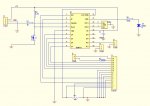Hi all,
I am having trouble communicating with a 16x2 line LCD using the FRM010 chip and the Picaxe 08m. I have searched the forum and found some helpful ideas but I’m still unable to find the problem. I don’t know if it the circuit or the code I am sending.
The LCD is one just like this, it's from sureelectronics4 on ebay.
http://cgi.ebay.com.au/16x2-LCD-Orange-Characters-Black-backlight-HD44780-New_W0QQitemZ370356192809QQcmdZViewItemQQptZLH_DefaultDomain_0?hash=
I have made up a PCB and populated the board. When I turn the power on the welcome message briefly shows before the segments half fill in a triangle shape with dots that make up the segment. (if that make sense). The LED also comes on and stays on.
The code I have tried is:
I have also tried to interchange the N and the T but no difference.
Can someone also tell me what the difference is between the N and the T.
This is my circuit, I’m pretty sure it is correct, although another set of eyes checking it over wouldn’t hurt.
Thanks for any help that anyone can give me.
Mike
I am having trouble communicating with a 16x2 line LCD using the FRM010 chip and the Picaxe 08m. I have searched the forum and found some helpful ideas but I’m still unable to find the problem. I don’t know if it the circuit or the code I am sending.
The LCD is one just like this, it's from sureelectronics4 on ebay.
http://cgi.ebay.com.au/16x2-LCD-Orange-Characters-Black-backlight-HD44780-New_W0QQitemZ370356192809QQcmdZViewItemQQptZLH_DefaultDomain_0?hash=
I have made up a PCB and populated the board. When I turn the power on the welcome message briefly shows before the segments half fill in a triangle shape with dots that make up the segment. (if that make sense). The LED also comes on and stays on.
The code I have tried is:
Code:
setfreq m4
high 0
pause 100
serout 0,N2400_4,(254,1) ' blank the screen
pause 30 ' short delay to enable blank to complete
serout 0,N2400_4,(254,128,"Top Line") ' top line message
serout 0,N2400_4,(254,192,"Bottom Line") ' bottom line message
pause 2000
Main: 'start a loop
let b1 = b1 + 1 ' increment variable
pause 500 ' short delay
serout 0,T2400_4,(254,192,"Count = ", #b1) ' output value on bottom line
goto main
--------------------------------------
AND THIS
--------------------------------------
setfreq m4
high 0
pause 100
main:
for b0 = 0 to 63 ‘ start a loop
read b0,b1 ‘ read value into b1
serout 0,N2400_4,(b1) ‘ transmit value to serial LCD
next b0 ‘ next loopCan someone also tell me what the difference is between the N and the T.
This is my circuit, I’m pretty sure it is correct, although another set of eyes checking it over wouldn’t hurt.
Thanks for any help that anyone can give me.
Mike
Attachments
-
81 KB Views: 32



